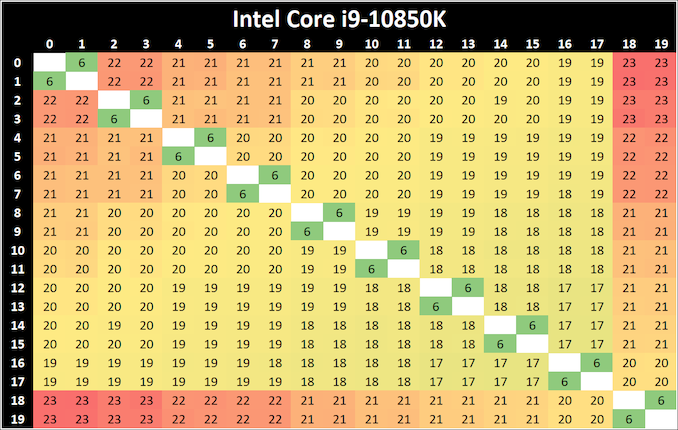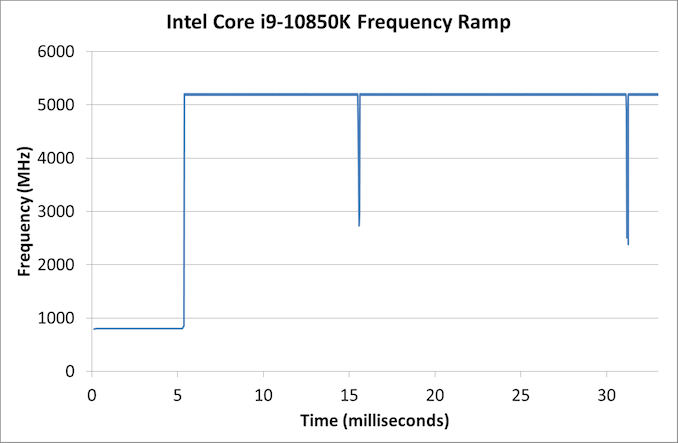Intel Core i9-10850K Review: The Real Intel Flagship
by Dr. Ian Cutress on January 4, 2021 9:00 AM EST- Posted in
- CPUs
- Intel
- Core
- Z490
- 10th Gen Core
- Comet Lake
- LGA1200
- i9-10850K
CPU Tests: Microbenchmarks
Core-to-Core Latency
As the core count of modern CPUs is growing, we are reaching a time when the time to access each core from a different core is no longer a constant. Even before the advent of heterogeneous SoC designs, processors built on large rings or meshes can have different latencies to access the nearest core compared to the furthest core. This rings true especially in multi-socket server environments.
But modern CPUs, even desktop and consumer CPUs, can have variable access latency to get to another core. For example, in the first generation Threadripper CPUs, we had four chips on the package, each with 8 threads, and each with a different core-to-core latency depending on if it was on-die or off-die. This gets more complex with products like Lakefield, which has two different communication buses depending on which core is talking to which.
If you are a regular reader of AnandTech’s CPU reviews, you will recognize our Core-to-Core latency test. It’s a great way to show exactly how groups of cores are laid out on the silicon. This is a custom in-house test built by Andrei, and we know there are competing tests out there, but we feel ours is the most accurate to how quick an access between two cores can happen.
When we first reviewed the 10-core Comet Lake processors, we noticed that a core (or two) seemed to take slightly longer to ping/pong than the others. We see the same pattern here again with the final core.
Frequency Ramping
Both AMD and Intel over the past few years have introduced features to their processors that speed up the time from when a CPU moves from idle into a high powered state. The effect of this means that users can get peak performance quicker, but the biggest knock-on effect for this is with battery life in mobile devices, especially if a system can turbo up quick and turbo down quick, ensuring that it stays in the lowest and most efficient power state for as long as possible.
Intel’s technology is called SpeedShift, although SpeedShift was not enabled until Skylake.
One of the issues though with this technology is that sometimes the adjustments in frequency can be so fast, software cannot detect them. If the frequency is changing on the order of microseconds, but your software is only probing frequency in milliseconds (or seconds), then quick changes will be missed. Not only that, as an observer probing the frequency, you could be affecting the actual turbo performance. When the CPU is changing frequency, it essentially has to pause all compute while it aligns the frequency rate of the whole core.
We wrote an extensive review analysis piece on this, called ‘Reaching for Turbo: Aligning Perception with AMD’s Frequency Metrics’, due to an issue where users were not observing the peak turbo speeds for AMD’s processors.
We got around the issue by making the frequency probing the workload causing the turbo. The software is able to detect frequency adjustments on a microsecond scale, so we can see how well a system can get to those boost frequencies. Our Frequency Ramp tool has already been in use in a number of reviews.
The Core i9-10850K ramps up extremely quickly from idle to peak turbo, in the region of about 5 milliseconds. This is faster than the 16 ms we typically observe.












126 Comments
View All Comments
dwillmore - Wednesday, January 6, 2021 - link
FWIW, your y-cruncher link goes to a file on your C drive: file:///C:/Users/admin/AppData/Roaming/Microsoft/Word/www.numberworld.org/y-cruncherShowtime - Friday, January 8, 2021 - link
What cooler was used for this review?hellocopter - Wednesday, January 13, 2021 - link
Who in their right mind would buy anything Intel over AMD? Things are getting rather embarrassing for Intel..sonicmerlin - Sunday, January 17, 2021 - link
I bought a I5-2500k for $200 back in the day when it was top of the line... when did CPUs become so expensive...?FluxApex - Monday, March 8, 2021 - link
I have an i9-10850k and have yet to see my temps go above 79c stock clock, 85c overclocked to 5.0ghz all cores. This is with a cheap $80 deepcool captain aio. My Cryorig R1 maintains lower temps than this but has more noise due to being a heat pipe air cooler.Thorough review, but I have a problem with the CPU cooler they are using. Thermalright's website even says it is meant for an i7 CPU. The Thermalright True Copper is not meant for this TDP. Also, the cooler has been documented on several occasions to have improper machining on the base.
They need to use a proper cooler, just do a quick youtube search of all the overclocking videos for the i9-10850k and none will have temps near this.
Quartz11 - Tuesday, March 23, 2021 - link
Is that 5nm “speed shift” difference, down from the 16nm of 10900K, relevant/noticeable for intensive home office type use? That graph seems to be excluded from any further discussion, and in fact 10900K is still recommended over 10850K if price is similar enough in the conclusion.In my case, the price difference is very small, and I was going to get the 10900K variant. But that Frequency Ramp graph is causing some doubts.